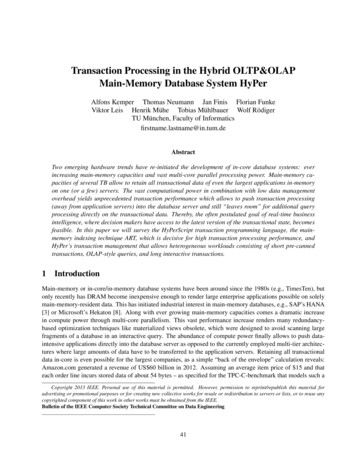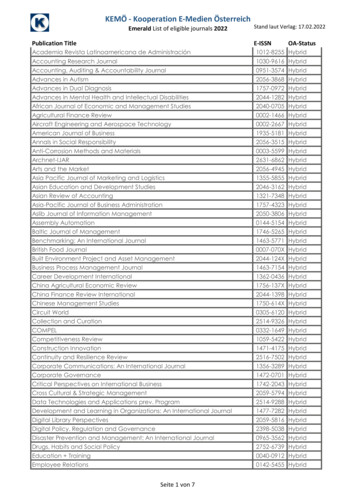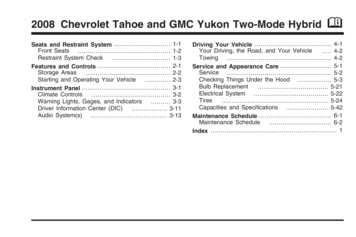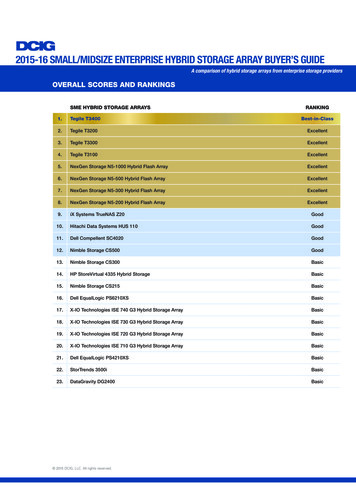
Transcription
Transaction Processing in the Hybrid OLTP&OLAPMain-Memory Database System HyPerAlfons Kemper Thomas Neumann Jan Finis Florian FunkeViktor Leis Henrik Mühe Tobias Mühlbauer Wolf RödigerTU München, Faculty of Informaticsfirstname.lastname@in.tum.deAbstractTwo emerging hardware trends have re-initiated the development of in-core database systems: everincreasing main-memory capacities and vast multi-core parallel processing power. Main-memory capacities of several TB allow to retain all transactional data of even the largest applications in-memoryon one (or a few) servers. The vast computational power in combination with low data managementoverhead yields unprecedented transaction performance which allows to push transaction processing(away from application servers) into the database server and still “leaves room” for additional queryprocessing directly on the transactional data. Thereby, the often postulated goal of real-time businessintelligence, where decision makers have access to the latest version of the transactional state, becomesfeasible. In this paper we will survey the HyPerScript transaction programming language, the mainmemory indexing technique ART, which is decisive for high transaction processing performance, andHyPer’s transaction management that allows heterogeneous workloads consisting of short pre-cannedtransactions, OLAP-style queries, and long interactive transactions.1IntroductionMain-memory or in-core/in-memory database systems have been around since the 1980s (e.g., TimesTen), butonly recently has DRAM become inexpensive enough to render large enterprise applications possible on solelymain-memory-resident data. This has initiated industrial interest in main-memory databases, e.g., SAP’s HANA[3] or Microsoft’s Hekaton [8]. Along with ever growing main-memory capacities comes a dramatic increasein compute power through multi-core parallelism. This vast performance increase renders many redundancybased optimization techniques like materialized views obsolete, which were designed to avoid scanning largefragments of a database in an interactive query. The abundance of compute power finally allows to push dataintensive applications directly into the database server as opposed to the currently employed multi-tier architectures where large amounts of data have to be transferred to the application servers. Retaining all transactionaldata in-core is even possible for the largest companies, as a simple “back of the envelope” calculation reveals:Amazon.com generated a revenue of US 60 billion in 2012. Assuming an average item price of 15 and thateach order line incurs stored data of about 54 bytes – as specified for the TPC-C-benchmark that models such aCopyright 2013 IEEE. Personal use of this material is permitted. However, permission to reprint/republish this material foradvertising or promotional purposes or for creating new collective works for resale or redistribution to servers or lists, or to reuse anycopyrighted component of this work in other works must be obtained from the IEEE.Bulletin of the IEEE Computer Society Technical Committee on Data Engineering41
retailer – we derive a total data volume of less than 1/4 TB per year for the order lines, which is the dominatingrepository in such a sales application. This estimate neither includes other data (customer and product data)which increases the volume nor the possibility to compress the data to decrease the volume. Nevertheless it issafe to assume that the yearly transactional sales data can be fit into the main memory of a large scale server witha few TB capacity. To unleash the immense computing power of such a multi-core server, a radical reengineering of database technology is required in several areas: low-overhead data representation, compiled instead ofinterpreted code, high-performance indexing and low-cost transaction synchronization are addressed here. Sucha low-overhead database on a multi-core server would not even be saturated by the transaction (Tx) processing asa simple calculation reveals: On average, Amazon.com has only 127 sales Tx per second (in peak times they report a few thousand), while a main-memory database system like HyPer achieves around 100,000 Tx per secondin the TPC-C benchmark. Thus, besides the mission critical transaction processing there is room for additionalOLAP-style query processing – if they don’t interfere with each other. HyPer allows this via a highly efficientvirtual memory snapshotting mechanism. These virtual memory snapshots are created frequently and shieldthe complex OLAP query processing entirely from the mission-critical OLTP processing without any kind of(software) concurrency control. These snapshots are also leveraged for tentative execution of long transactionswhose effect are then, after validation, applied to the main database as a short install transaction.2Transaction Scripting and CompilationTransactions are implemented in HyPerScript, a SQL-based programming language. The SQL query languageused for OLAP-style queries thereby is a subset of HyPerScript. For illustration purposes, we show the completeimplementation of the well-known newOrder transaction of the TPC-C benchmark [14].create procedure newOrder (w id integer not null, d id integer not null, c id integer not null,table positions(line number integer not null, supware integer not null,itemid integer not null, qty integer not null),datetime timestamp not null) // note the TABLE-valued parameter above{ select w tax from warehouse w where w.w id w id; // w tax value used laterselect c discount from customer c // c discount used in orderline insertwhere c w id w id and c d id d id and c.c id c id;select d next o id as o id,d tax from district d // get the next o idwhere d w id w id and d.d id d id;update district set d next o id o id 1 // increment the next o idwhere d w id w id and district.d id d id;select count(*) as cnt from positions; // how many items are orderedselect case when count(*) 0 then 1 else 0 end as all localfrom positions where supware w id;insert into "order" values (o id,d id,w id,c id,datetime,0,cnt,all local);insert into neworder values (o id,d id,w id); // insert reference to orderupdate stockset s quantity case when s quantity qty then s quantity-qty else s quantity 91-qty end,s remote cnt s remote cnt case when supware w id then 1 else 0 end,s order cnt s order cnt case when supware w id then 1 else 0 endfrom positions where s w id supware and s i id itemid;insert into orderline // insert all the order positionsselect o id,d id,w id,line number,itemid,supware,null,qty,qty*i price*(1.0 w tax d tax)*(1.0-c discount),case d id when 1 then s dist 01 when 2 then s dist 02 when 3 then s dist 03when 4 . when 9 then s dist 09 when 10 then s dist 10 endfrom positions, item, stockwhere itemid i id and s w id supware and s i id itemidreturning count(*) as inserted; // how many were inserted?if (inserted cnt) rollback; // not all invalid item abort};42
Figure 1: Compiling SQL queries into LLVM CodeThe declarative HyPerScript language exhibits the following uncommon constructs that are present in theabove script:Table parameter. Frequently, a stored procedure is invoked for an entire collection of tuples, each consistingof several attribute values. Flattening the collection would result in a large number of parameters; a moreelegant solution is provided by HyPerScript’s table parameter that allows to pass an entire table – asdemonstrated by the positions table in the newOrder script.Reusing query results. In HyPerScript a query result can be reused in subsequent statements by referring toa prior assigned variable. For example, the first query of our newOrder script determines the tax ratew tax of the particular warehouse. This w tax value is later used in the insert statement that populates theorderline table with the item’s price including the applicable tax.Using such a declarative scripting language has a number of advantages: (1) the declarative nature allows formuch more elegant and succinct code than in imperative languages – cf. the complete newOrder script; (2) theSQL statements can be optimized and executed like regular queries in the same query engine; (3) declarative HyPerScripts are much more amenable for security analysis than imperative programs. Thus, using the declarativeHyPerScript language allows us to safely run compiled transactions within the database server process withoutany costly inter-procedural communication and context switching.Stored procedures as well as regular (stand-alone) SQL queries are compiled into LLVM code [13]. LLVMconstitutes a machine independent assembly language that is then further compiled and optimized for the particular server machine. The left-hand side of Fig. 1 shows a logical algebra plan for a three-way join includingsome selections and an (early) aggregation. Instead of the recently propagated vector-wise processing technique[2], HyPer’s query engine relies on a data-centric execution model that exploits pipelining as much as possible.For this purpose, the query evaluation plan (QEP) is segmented into pipelines that end at pipeline breakers. Asshown in the middle of Fig. 1, our example query has four such pipelines: the leftmost pipeline ends at thehash-table build of the upper join; R2 -tuples are scanned and selected up to the (hash) groupify. From there on,they are forwarded to the hash-table build of the lower join. Finally, R3 -tuples are propelled “in one go” via thefirst join all the way up to the upper join and produce output tuples by probing the hash-join table.Thus, once a data object is accessed it is processed as much as possible. This way the query processingachieves maximal data locality as an object is transferred to a machine register as few times as possible.43
byte representationinteger keybit representation (32 bit, unsigned) 21823743900001101 00000010 00001001 11111111 ② 13 29 255 r Node4 13 129130A ①012 r3 255 Node48NR ②Node16DTYE 389255ANTANYARE TART r0AND r Node2561TID2345TIDTIDTIDTID6255TIDFigure 2: The Adaptive Radix Tree ART: (left) general idea of different sized nodes, (right) a sample path forthe key 218237439 traversing all four node typesThe right-hand side of Fig. 1 illustrates the translation of queries into corresponding LLVM/C code.The typical algorithms of a query engine, such as scans, hash-join table building and probing, grouping andaggregation, are pre-implemented in the high-level programming language C . These C building blocks are“glued together” by generated LLVM – as (metaphorically) sketched for the rightmost pipeline of the exampleQEP. The generated LLVM code (the chain) makes the C query operators (the cog wheels) work together inevaluating an entire pipeline.3ARTful Indexing in Main-Memory DatabasesThe efficiency of transaction processing largely depends on which index structures are used, as exemplifiedby the first three select-statements of the newOrder implementation. In main-memory, dictionary-like datastructures supporting insert, update, and delete are often implemented as hash tables or comparison-based trees(e.g. self-balancing binary trees or B-trees). Hashing is usually much faster than a tree as it offers constantlookup time in contrast to the logarithmic behavior of comparison-based trees. The advantage of trees is thatthe data is stored in sorted order, which enables additional operations like range scan, minimum, maximum, andprefix lookup.The radix tree, also known as trie, prefix tree, or digital search tree, is another dictionary-like data structure.In contrast to comparison-based structures, which compare opaque key values using a comparison function,radix trees directly use the binary representation of the key. Although radix trees are often introduced as a datastructure for storing character strings (cf., left hand side of Fig. 2), they can be used to store any data type byconsidering values as strings of bits or bytes.The complexity of radix trees for insert, lookup, and delete is O(k) where k is the length of the key. Theaccess time is independent of the number of elements stored. Besides the length of the key, the height of a radixtree depends on the number of children each node has. For example, a radix tree with a fanout of 256 that stores32 bit integers has a height of 4.So far radix trees suffered from space underutilization problems as typically an array of 256 pointers was44
forkTx-consistent SnapshotOLAP QueriesbOLTP Requests /TxUccRead cRead aapdaÆD¶ D¶Virtual MemoryCopw yorit neeatdbFigure 3: Virtual Memory Snapshots: (left) to separate OLTP & OLAP; (right) OLAP queries and long Txare delegated to the snapshot (A), short transactions are executed on the main (B), long Tx are optimisticallyexecuted on the snapshot (C) and re-executed after validation as an apply transaction (E) on the mainallocated for each node – even though some nodes might have a very low fan-out compared to others. Therefore,we developed the Adaptive Radix Tree (ART), which uses four different node types that can handle up to (i)4, (ii) 16, (iii) 48, and (iv) 256 entries. Thereby, a good space utilization of ART-trees is guaranteed while stillbeing able to achieve a maximum height of k for k-byte keys. That is, 32 bit integers are indexed with a tree ofheight 4, 64 bit integers require height 8. These adaptive nodes are exemplified by the sample path for the 32-bitkey 218237439 consisting of the the 4 byte-chunks 13&2&9&255 on the right-hand side of Fig. 2. This pathstarts at the root, which happens to be of type Node4, and then covers the three other node types. The structuralrepresentation of these node types varies, as illustrated in the figure. In designing the node structure the trade-offbetween space utilization and intra-node search performance was taken into account.Besides adaptive nodes, we employ two well-known techniques that reduce both the tree height and thespace consumption. First, we build the tree lazily, i.e., any path that leads to a single leaf is truncated. As aconsequence, the leaf is stored higher up in the tree. Only when another key with a shared prefix is inserted, anadditional inner node is created as a “goalpost” between the two leaves. The second technique, path compression,removes each common path (e.g., “http://” when indexing URLs) and instead stores the path as an additionalprefix of the following inner node. This avoids cache-inefficient chains of one-way nodes. When indexinglong keys, lazy expansion and path compression are very effective in reducing the tree height. Additionally, thetwo optimizations allow to bound the worst-case space consumption per key/value pair to 52 bytes – even forarbitrarily long keys [9].4 Isolation of Long Running TransactionsOriginally, HyPer focussed on the execution of short, pre-canned transactions and OLAP-style, read-onlyqueries which are executed on a snapshot of the data that is generated using the UNIX fork-mechanism [7, 10].The snapshot is kept consistent by the memory management unit (MMU) via the copy-on-write procedure thatwill (automatically) detect shared pages and copy them prior to any update, as illustrated on the left of Fig. 3.In this architecture the OLTP process “owns” the database and periodically (e.g., in the order of secondsor minutes) forks an OLAP process. This OLAP process constitutes a fresh transaction-consistent snapshot ofthe database. Thereby, the OLAP processing is completely separated from the OLTP processing without any(software) concurrency control mechanism. Whenever an object (such as a in the figure) on a shared page ismodified, the MMU automatically creates a page copy via the copy-on-write mechanism.The OLTP transactions are executed serially on (partitions of) the transactional database state – as pioneered45
by H-Store/VoltDB [6, 15]. Even though this yields unprecedented performance, serial execution is restricted toshort and pre-canned transactions.This makes main-memory database systems using serial execution unsuitable for “ill-natured” transactionslike long-running OLAP-style queries or transactions querying external data – even if they occur rarely in theworkload. In our approach [11], which we refer to as tentative execution, the coexistence of short and longrunning transactions in main-memory database systems does not require recommissioning traditional concurrency control techniques like two phase locking. Instead, the key idea is to tentatively execute long-runningtransactions on a transaction-consistent database snapshot, that exists for OLAP queries anyway. Thereby, along transaction is converted into a short “apply transaction” which is then, after validation, re-executed on themain database, as illustrated on the right of Fig. 3.Different mechanisms can be used to separate the workload into short and long transactions. A simpleapproach is limiting the runtime or number of tuples each transaction is allowed to use before it has to finish.When a transaction exceeds this allotment – which can vary depending on the transaction’s complexity or thenumber of partitions it accesses – it is rolled back using the undo log and re-executed using tentative execution.Our approach is optimistic in that it queues and then executes transactions on a consistent snapshot of thedatabase. This is advantageous as no concurrency control is required to execute short and apply transactions.Similar to other optimistic execution concepts a validation phase is required which makes some form of monitoring necessary.During the apply phase, the effects of the transaction as performed on the snapshot are validated on the maindatabase and then applied. This is done by injecting an “apply transaction” into the serial execution queue ofthe main database. As opposed to the transaction that ran on the snapshot, the apply transaction only needs tovalidate the work done on the snapshot, not re-execute the original transaction in its entirety or wait for externalresources.Specifically, we distinguish between two cases: When serializability is requested, all reads have to be validated. To achieve this, it is checked whether or not the read performed on the snapshot is identical to what wouldhave been read on the main database. Depending on the monitoring granularity, the action performed here rangesfrom actually performing the read a second time on the main database to comparing version counters betweensnapshot and main.When snapshot isolation is used, the apply transaction ensures that none of the tuples written on the snapshothave changed in the main database, therefore guaranteeing that the write sets of both the tentative transactionas well as all transactions that have committed on the main database after the snapshot was created are disjoint.This is achieved by either comparing the current tuple values to those saved in the log or by checking that allversion counters for written tuples are equal both during the execution on the snapshot and on the main database.5Conclusion and Ongoing WorkThe high performance of HyPer is due to several design decisions: (1) compiling SQL queries and HyPerScripttransactions into LLVM assembler code instead of interpreted execution; (2) the new radix tree indexing whichoffers performance similar to hash tables while allowing range scans; (3) the virtual memory snapshot mechanism which entirely shields OLTP from OLAP without any (software controlled) synchronization; (4) lock-freepartition-serial execution of short transactions while (5) long transactions are executed optimistically on thesnapshot and then applied to the main database like a short transaction. Currently we are working on parallelizing the query execution [1], compacting the working set of the transactional database [5], supporting versionedhierarchical data [4], bulk data loading, and scaling out to processor clusters [12].46
References[1] M.-C. Albutiu, A. Kemper, and T. Neumann. Massively parallel sort-merge joins in main-memory multicore database systems. PVLDB, 5(10):1064–1075, 2012.[2] P. A. Boncz, M. Zukowski, and N. Nes. MonetDB/X100: Hyper-pipelining query execution. In DaMoN,2005.[3] F. Färber, S. K. Cha, J. Primsch, C. Bornhövd, S. Sigg, and W. Lehner. SAP HANA database: datamanagement for modern business applications. SIGMOD Record, 40(4):45–51, 2011.[4] J. Finis, R. Brunel, A. Kemper, T. Neumann, F. Färber, and N. May. DeltaNI: An efficient labeling schemefor versioned hierarchical data. In SIGMOD, 2013.[5] F. Funke, A. Kemper, and T. Neumann. Compacting transactional data in hybrid OLTP&OLAP databases.PVLDB, 5(11):1424–1435, 2012.[6] R. Kallman, H. Kimura, J. Natkins, A. Pavlo, A. Rasin, S. B. Zdonik, E. P. C. Jones, S. Madden, M. Stonebraker, Y. Zhang, J. Hugg, and D. J. Abadi. H-store: a high-performance, distributed main-memory transaction processing system. PVLDB, 1(2):1496–1499, 2008.[7] A. Kemper and T. Neumann. HyPer: A hybrid OLTP&OLAP main-memory database system based onvirtual memory snapshots. In ICDE, pages 195–206, 2011.[8] P.-Å. Larson, S. Blanas, C. Diaconu, C. Freedman, J. M. Patel, and M. Zwilling. High-performanceconcurrency control mechanisms for main-memory databases. PVLDB, 5(4):298–309, 2011.[9] V. Leis, A. Kemper, and T. Neumann. The Adaptive Radix Tree: ARTful indexing for main-memorydatabases. In ICDE, 2013.[10] H. Mühe, A. Kemper, and T. Neumann. How to efficiently snapshot transactional data: hardware orsoftware controlled? In DaMoN, pages 17–26, 2011.[11] H. Mühe, A. Kemper, and T. Neumann. Executing long-running transactions in synchronization-free mainmemory database systems. In CIDR, 2013.[12] T. Mühlbauer, W. Rödiger, A. Reiser, A. Kemper, and T. Neumann. ScyPer: Elastic OLAP throughput ontransactional data. In Workshop on Data analytics in the Cloud (DanaC), 2013.[13] T. Neumann. Efficiently compiling efficient query plans for modern hardware. PVLDB, 2011.[14] Transaction Processing Performance Council. TPC-C specification. www.tpc.org/tpcc/spec/TPC-C\ v5-11.pdf, 2010.[15] VoltDB. Technical Overview. http://www.voltdb.com, March 2010.47
In main-memory, dictionary-like data structures supporting insert, update, and delete are often implemented as hash tables or comparison-based trees (e.g. self-balancing binary trees or B-trees). Hashing is usually much faster than a tree as it offers constant lookup time in contrast to the logarithmic behavior of comparison-based trees.











